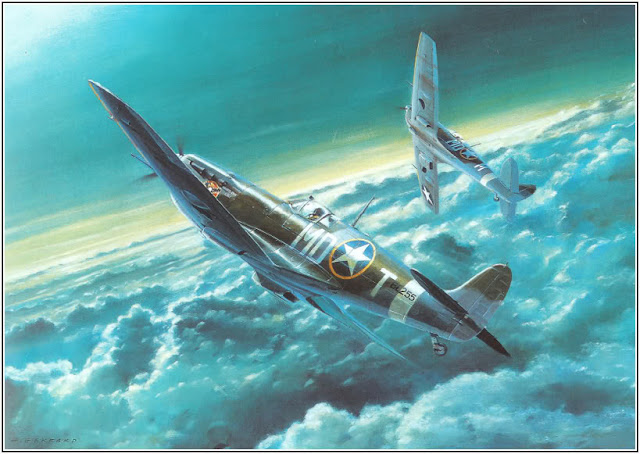Some illustrators are generalists when it comes to their subject-matter. Others find themselves specializing, either through choice or by force of circumstances. One field that supports some specialists is military-related subjects. Back on 10 August 2009 on the 2Blowhards blog I posted this article on British illustrator Terence Cuneo who focused on railroads and warfare using a painterly style. And on the 3rd of that month I wrote about Frank Wootton who specialized in automobiles and aircraft.
A currently active British illustrator who deals with warfare and related subjects is Howard Gerrard whose style is also painterly, though its appearance differs from the others because they generally painted in oils and Gerrard often seems to work in gouache or a similar medium which produces a flatter effect.
A short session on Google turned up but a tiny amount of information about Gerrard. He has a Web site, but it's "under construction" and we'll just have to wait until the scaffolding has been removed and the Queen cuts the ribbon to inaugurate services.
The Gerrard information that I found is here on the site of Osprey, a publisher that focuses on short, focused, illustrated books about military subjects. Gerrard has illustrated a number of their volumes and is given credit on the covers and title pages.
In my opinion, Gerrard is the best of Osprey's team of illustrators, producing informative and visually satisfying images that both complement and supplement the text, diagrams and photographs found in a typical Osprey publication. The Osprey illustrations are based on the requirement that various parts of the images be indexed and explained on a following page. This meant that Garrard probably had to keep more elements in sharp focus than he might have were he able to focus on aesthetic considerations.
Here are some examples of Gerrard's work.
Gallery
Assault on Red October steel plant, Stalingrad
El Alamein battle scene
Sherman tank attacking German artillery
The three images above appear to be from Osprey books dealing with specific operations or campaigns in World War 2. As noted above, much of each illustration is in sharp focus though Gerrard was able to get painterly in a few places.
Clipped-wing Spitfires
This does not appear to be from an Osprey book and seems to be painted in oils or acrylics. It reminds me of Frank Wootton's paintings, but with a higher degree of accuracy -- Wootton tended to freehand his subjects rather than construct them using formal, architectural perspective methods.
Doolittle raider approaching Yokohama - 1
Doolittle raider approaching Yokohama - 2
These two images are details from an illustration in this Osprey book dealing with the famous 18 April 1942 raid led by Jimmy Doolittle against Tokyo and other Japanese cities. As you might recall, B-25 Army medium bombers were launched from the aircraft carrier Hornet in a daring effort that had a great deal of psychological impact for both Americans and Japanese. Historians have argued that the raid spurred the Japanese to attack the island of Midway, a turning-point battle that resulted in the loss of four of their aircraft carriers and many of their best pilots.
These images are scans from the book and don't show the subtleties you would notice when viewing the printed page. There is a good deal of painterly gouache here because the focus is on the B-25 and very little on other elements. I encourage you to examine a copy or even purchase one.
Update: Reader Richard Sullivan commented to inform me that the Stalingrad image is actually by Peter Dennis.






4 comments:
Howard Gerrard is a wonderful artist, bringing scenes to life with accuracy and verve. Equally wonderful is Peter Dennis. The first picture of Stalingrad is one of his.
Thank you for highlighting their work!
Richard -- Sorry about the Stalingrad picture ID; I grab this stuff off the Web, and sometimes the sources I use have it wrong. Where possible, I try to double-check, but didn't in this case. I'll post your correction.
Thanks for the heads-up.
No worries. Both are wonderful artists. I've been lucky enough to observe Peter in action. Not only is he brilliantly accurate, he is also incredibly fast.
Post a Comment